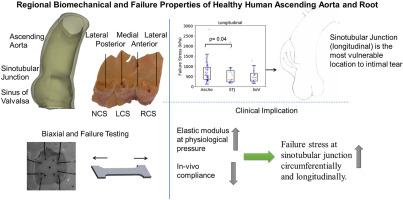Journal of the Mechanical Behavior of Biomedical Materials ( IF 3.3 ) Pub Date : 2021-08-14 , DOI: 10.1016/j.jmbbm.2021.104705 Yue Xuan 1 , Andrew D Wisneski 1 , Zhongjie Wang 1 , Matthew Lum 1 , Shalni Kumar 1 , Julia Pallone 1 , Nick Flores 1 , Justin Inman 1 , Lilian Lai 1 , Joanna Lin 1 , Julius M Guccione 1 , Elaine E Tseng 1 , Liang Ge 1

|
Purpose
Aortic dissection (AD) is a life-threatening event that occurs when the intimal entry tear propagates and separates inner from outer layers of the aorta. Diameter, the current criterion for aneurysm repair, is far from ideal and additional evidence to optimize clinical decision would be extremely beneficial. Biomechanical investigation of the regional failure properties of aortic tissue is essential to understand and proactively prevent AD. We previously studied biaxial mechanical properties of healthy human aorta. In this study, we investigated the regional failure properties of healthy human ascending aorta (AscAo) including sinuses of Valsalva (SOV), and sinotubular junction (STJ).
Results
A total of 430 intact tissue samples were harvested from 19 healthy donors whose hearts were excluded from heart transplantation. The donors had mean age of 51 ± 11.7 years and nearly equal gender distribution. Samples were excised from aortic regions and subregions at defined locations. Tissue strips were subjected to either biaxial or uniaxial failure testing. Wall thickness varied regionally being thickest at AscAo (2.08 ± 0.66 mm) and thinnest at SOV (1.46 ± 0.31 mm). Biaxial testing demonstrated hyperplastic behavior of aortic tissues. Posterior and lateral STJ subregions were found to be stiffer than anterior and medial subregions in both circumferential and longitudinal directions. Failure stresses were significantly higher in the circumferential than longitudinal directions in each subregion of AscAo, STJ, and SOV. Longitudinal failure stresses were significantly greater in AscAo than those in STJ or SOV. Longitudinal failure stresses in AscAo were much smaller anteriorly than posteriorly, and medially than laterally.
Conclusions
The finding of weakest region at the sinotubular junction along the longitudinal direction corroborates clinical observations of that region being commonly involved as the initial site of intimal tear in aortic dissections. Failure stretch ratios correlated to elastic modulus at each region. Furthermore, strong correlation was seen between STJ failure stresses and elastic modulus at physiological pressure along both circumferential and longitudinal directions. Correlating in-vivo aortic elastic modulus based on in-vivo imaging with experimentally determined elastic modulus at physiological pressure and failure stresses may potentially provide valuable information regarding aortic wall strength. Better understanding of aortic biomechanics in normal physiologic and aneurysmal pathologic states may aid in determining risk factors for predicting dissection in patient-specific fashion.
中文翻译:

健康人升主动脉和根部的区域生物力学和失效特性
目的
主动脉夹层 (AD) 是一种危及生命的事件,当内膜入口撕裂传播并将主动脉的内层与外层分开时,就会发生这种情况。直径,目前动脉瘤修复的标准,远非理想,优化临床决策的额外证据将非常有益。主动脉组织局部衰竭特性的生物力学研究对于了解和主动预防 AD 至关重要。我们之前研究了健康人体主动脉的双轴力学性能。在这项研究中,我们调查了健康人升主动脉 (AscAo) 的区域衰竭特性,包括 Valsalva 窦 (SOV) 和窦管交界处 (STJ)。
结果
从 19 名心脏被排除在心脏移植之外的健康供体中采集了总共 430 份完整的组织样本。捐赠者的平均年龄为 51 ± 11.7 岁,性别分布几乎相等。在确定的位置从主动脉区域和亚区域切除样本。对组织条进行双轴或单轴失效测试。壁厚在区域上有所不同,在 AscAo (2.08 ± 0.66 mm) 处最厚,在 SOV (1.46 ± 0.31 mm) 处最薄。双轴测试证明了主动脉组织的增生行为。发现后部和外侧 STJ 子区域在圆周和纵向方向上都比前部和内侧子区域更硬。在 AscAo、STJ 和 SOV 的每个子区域中,周向的破坏应力明显高于纵向。AscAo 的纵向破坏应力明显大于 STJ 或 SOV。AscAo 中的纵向破坏应力在前部比后部小得多,在内侧比在外侧小得多。
结论
沿纵向在窦管交界处发现最薄弱区域证实了该区域通常作为主动脉夹层中内膜撕裂的初始部位涉及的临床观察。失效拉伸比与每个区域的弹性模量相关。此外,在生理压力下沿周向和纵向的 STJ 失效应力和弹性模量之间存在很强的相关性。基于体内的相关体内主动脉弹性模量在生理压力和失效应力下通过实验确定的弹性模量进行成像可能会提供有关主动脉壁强度的有价值信息。更好地了解正常生理和动脉瘤病理状态下的主动脉生物力学可能有助于确定以患者特异性方式预测夹层的风险因素。











































 京公网安备 11010802027423号
京公网安备 11010802027423号